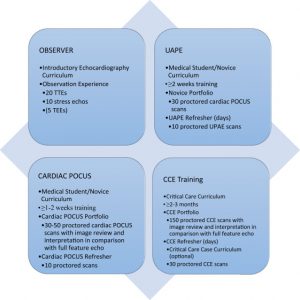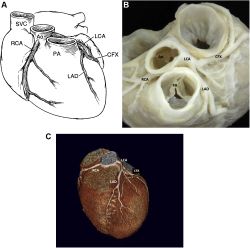 The April JASE contains, “Recommendations for Echocardiography Laboratories Participating in Cardiac Point of Care Cardiac Ultrasound (POCUS) and Critical Care Echocardiography Training.” Lead author James N. Kirkpatrick, MD, FASE, of the University of Washington Medical Center said, “This guideline arose out of the foresight of ASE Past President Jonathan Lindner and the ASE Executive Committee, who recognized the importance of providing guidance to echocardiography laboratories serving as partners with point of care ultrasound and critical care echocardiography clinicians.” In light of the COVID-19 pandemic, cardiac POCUS and Critical Care Echo (CCE) may play an important role in the bedside assessment of ill patients. A podcast on this guideline is available online.
The April JASE contains, “Recommendations for Echocardiography Laboratories Participating in Cardiac Point of Care Cardiac Ultrasound (POCUS) and Critical Care Echocardiography Training.” Lead author James N. Kirkpatrick, MD, FASE, of the University of Washington Medical Center said, “This guideline arose out of the foresight of ASE Past President Jonathan Lindner and the ASE Executive Committee, who recognized the importance of providing guidance to echocardiography laboratories serving as partners with point of care ultrasound and critical care echocardiography clinicians.” In light of the COVID-19 pandemic, cardiac POCUS and Critical Care Echo (CCE) may play an important role in the bedside assessment of ill patients. A podcast on this guideline is available online.
New POCUS Training Guideline in April JASE
ASE Headquarters – COVID-19 Update
Beginning March 26, 2020, in compliance with the Durham County North Carolina order to “Stay at Home” due to the spread of coronavirus, the entire ASE staff will be working remotely through May 25. We are not suspending or closing operations; our employees will remain working and providing excellent customer service to our members and the cardiovascular ultrasound community. However, ASE will slightly modify its official open hours to 9 AM – 4 PM Eastern Time, Monday-Friday. Should you need to get in touch with a staff person, call our main office at 919-861-5574 and a phone list by department will be available. A staff directory is also available here. All general questions can also be sent through ASE@ASEcho.org. Thank you and our best wishes for your continued safety.
COVID-19 & ASE Live Courses
Review Course
The health, well-being, and safety of our live course attendees is of the utmost importance, and to that end ASE is closely monitoring the coronavirus (COVID-19) situation. On March 17, 2020, the ASE Executive Committee decided to cancel the live ASCeXAM/ReASCE Review Course in Boston, MA, on May 9-12 and offer it as a virtual online course. For more information on registering to attend this meeting virtually, click here.
ASE Scientific Sessions
The ASE Executive Committee held a special call on Tuesday, March 31, and made the decision to cancel the ASE 2020 Scientific Sessions scheduled to be held in Denver, CO, on June 19-22, 2020. The decision to cancel our Scientific Sessions was difficult, but the health, well-being, and safety of our members, staff, exhibitors, and attendees is of utmost importance during this COVID-19 pandemic. With the majority of our ASE members on the front lines, it was in the best interest of everyone that we cancel the meeting to ensure the safety of everyone. We know that our Annual ASE Scientific Sessions are a time that our community, from all over the world, looks forward to every year. We greatly appreciate the effort our Program Planning Committee, led by course chairs Theodore Abraham, MD, FASE, and Sue Phillip, RCS, FASE, have put into creating the content for ASE 2020. We are currently working on a plan to deliver elements of the program and provide access to innovation, resources, and information that will advance your ability to improve patient care. We are also developing ways to recognize our award winners.
If you have any questions, please contact us at Registrar@ASEcho.org.
We have created a COVID-19 Resources page for our members.
New Guideline on Congenital Coronary Anomalies Multimodality Assessment Guideline in March JASE
 The March JASE contains, “Recommendations for Multimodality Assessment of Congenital Coronary Anomalies” Lead author Peter Frommelt, MD, FASE, of Children’s Hospital of Wisconsin and the Medical College of Wisconsin in Milwaukee said, “Congenital coronary artery anomalies, both in isolation and associated with other forms of congenital heart disease, have been recognized as having significant potential morbidity and mortality, including sudden cardiac death in children and adolescents. This document outlines specific strategies for imaging of each of the known congenital coronary anomalies, providing cardiac imaging specialists with a valuable resource to improve patient care and foster responsible utilization of diagnostic imaging modalities.”
The March JASE contains, “Recommendations for Multimodality Assessment of Congenital Coronary Anomalies” Lead author Peter Frommelt, MD, FASE, of Children’s Hospital of Wisconsin and the Medical College of Wisconsin in Milwaukee said, “Congenital coronary artery anomalies, both in isolation and associated with other forms of congenital heart disease, have been recognized as having significant potential morbidity and mortality, including sudden cardiac death in children and adolescents. This document outlines specific strategies for imaging of each of the known congenital coronary anomalies, providing cardiac imaging specialists with a valuable resource to improve patient care and foster responsible utilization of diagnostic imaging modalities.”
“Sinus of Valsalva Aneurysms: A State-of-the-Art Imaging Review” from Bo Xu, MB BS (Hons) FRACP, FACC, FASE, et al. is also in this issue. Clinical investigations explore contrast echocardiography, predicting heart failure risk from echocardiograms of coronary artery disease patients, topics in valvular heart disease, normal echocardiographic values in specific populations, and echocardiography in children. A pre-clinical investigation looks at how blood stasis imaging predicts cerebral microembolism during acute myocardial infarction.
Listen to the podcast by JASE social media team member, Amer M. Johri, MD, FASE, discussing “Association of Machine Learning-Derived Phenogroupings of Echocardiographic Variables with Heart Failure in Stable Coronary Artery Disease: The Heart and Soul Study” with co-author Geoffrey H. Tison, MD, MPH.
The President’s Message by Madhav Swaminathan, MD, MMCi, FASE, explores what differentiates ASE from other societies. Sue Phillip, RCS, FASE, writes in the Sonographers’ Communication about the Annual Scientific Sessions in Denver, and a special article by Drs. Ritu Thamman, Tejas Desai, David Wiener, and Madhav Swaminathan explores ASE’s Twitter Journal Club and how it is part of the changing paradigm in cardiology education.
Paying it Forward – Dr. Madhav Swaminathan’s March Presidential Blog

Madhav Swaminathan, MD, FASE, ASE President
“A few decades ago, I was offered a training position in another country. I was delighted to accept this offer, but there was one small problem. I couldn’t afford the cost of travel and accommodation for my family and I didn’t want to go alone. On learning about my predicament, an elderly gentleman, whom I vaguely knew, offered to help out. He provided me with the funds that enabled my family to travel with me. I was obviously concerned about the terms of this ‘loan’. While he didn’t ask for it to be returned, it did come with one condition – that one day when I am able to do so, I should pay it forward to another deserving trainee. In his words, he was making a worthwhile investment in the education of a deserving candidate, and hoped that its dividend would to be realized by a future trainee. He had no way of ensuring or guaranteeing that his transaction would reach its desired outcome, but relied on the goodwill and positive impact his act of kindness had created.” Read more here.
Join Us for a Live Webinar on Imaging in Obstructive Hypertrophic Cardiomyopathy
Please plan to join Jeremy James Thaden, MD, Ethan Rowin, MD, and Frederick Cobey, MD, MPH, FASE, for a LIVE webinar on Wednesday, March 18, 1:00 – 2:00 PM ET as they review Imaging in Obstructive Hypertrophic Cardiomyopathy: Utilizing Pre- and Peri-Procedure Echocardiography to Optimize Patient Care. Click here to find out when the webinar is taking place in your time zone.
By the end of this educational webinar, viewers will be able to:
- Recognize the dynamic nature of left ventricular outflow obstruction and the various provocative maneuvers that should be utilized in symptomatic patients without significant resting outflow gradient.
- Understand the role of imaging and echocardiography in deciding appropriate invasive septal reduction therapy option for an individual patient.
- Understand the role of imaging and echocardiography in helping guide surgical myectomy and alcohol septal ablation.
- Identify the characteristic features of mitral regurgitation secondary to systolic anterior motion of the mitral valve and left ventricular outflow obstruction versus primary mitral valve disease and its implications in deciding appropriate treatment strategies.
Earn 1 AMA PRA Category 1 Credit™ for attending this live webinar event. Registration is free for ASE members.
Imaging Experts Publish New Guideline For Multimodality Asessment of Congenital Coronary Anomalies
March 3, 2020, Durham, NC – Experts in the medical imaging community have developed a landmark consensus document to optimize care of patients with congenital coronary anomalies. These defects of the blood vessels that supply blood to the heart muscles can be an important cause of a heart attack and sudden cardiac death in children and young adults, but historically they have been difficult to identify without cardiac catheterization. However, recent advances in multimodality imaging techniques have demonstrated increasing utility in the characterization of most congenital coronary anomalies in all age groups, and these techniques can complement or reduce the need for invasive angiography in many cases. Recommendations for Multimodality Assessment of Congenital Coronary Anomalies: A Guide from the American Society of Echocardiography provides guidelines for optimization of imaging for congenital coronary anomalies, with a review of the benefits and limitations of the different imaging techniques, including echocardiography, cardiac computed tomography, cardiac magnetic resonance imaging, nuclear myocardial perfusion imaging, and angiography. This guideline was developed in collaboration with the Society for Cardiovascular Angiography and Interventions, the Japanese Society of Echocardiography, and the Society for Cardiovascular Magnetic Resonance, and has also been endorsed by 17 ASE International Alliance Partners. Read more here.
Technical Issues with the ASE Member Portal
We are aware of and apologize for the technical difficulties you may be experiencing with the ASE Member Portal. We hope to resolve this situation soon. Thank you for your patience.
Spectacular Attention to Detail! The February CASE Now Online
The latest issue of CASE, ASE’s online case reports journal, is now available and contains, “Misdiagnosis or Missed Diagnosis: Digging Out the “Near-Field Clutter” Artifact in a Patient with Stroke,” from Laurens De Vos, MD, Veerle De Herdt, MD, PhD, and Frank Timmermans, MD, PhD.” CASE co-Editor-in-Chief, Karen Zimmerman, BS, ACS, RDCS, RVT, FASE, writes in her editorial that this case stresses the importance of attention to detail and physics. “In this case, an apical LV thrombus was believed to be the cause of an embolic stroke due to a few questionable surface echo images. The patient was subject to multiple imaging examinations to finally reveal Near-Field Clutter (NFC). They also provide an excellent lesson and strategy for differentiation of NFC.”
The other illuminating cases in this issue look at imaging for percutaneous procedures crossing the atrial septum, masses/thrombosis, and sinus of Valsalva ruptures.
As CASE begins its 4th year of publishing cases that help its readers enhance their knowledge and provide outstanding healthcare for their patients, Karen G. Zimmerman, BS, ACS, RDCS, RVT, FASE, and L. Leonardo Rodriguez, MD, FACC, FASE, would like to thank everyone who is involved in creating such an impactful publication every two months. Without the generosity of reviewers, who take their personal time to review cases and work hard to help authors fine-tune their submissions, CASE would not be possible. The Editors-in-Chief would also like to thank CASE’s publisher, Elsevier, for its excellence in supporting the submission, proofing, and publication process. CASE always wants to hear from readers and potential authors with opinions and questions. Don’t hesitate to email managing editor, Deborah Meyer at DMeyer@ASEcho.org.
Next Twitter Journal Club – March 3
Interact with your colleagues in our next Twitter Journal Club on Tuesday, March 3, from 8:00 – 9:00 PM US EST. March’s Twitter Journal Club will review the latest ASE Guidelines, Guidelines for Performance, Interpretation, and Application of Stress Echocardiography in Ischemic Heart Disease. Guideline Chair, Patricia Pellikka, MD, FASE, ASE Past President, will join moderator, Ritu Thamman, MD, FASE, during this month’s Journal club.
NEW! As an ASE member, you can now receive FREE CME for participating. Register here BEFORE the Twitter Journal Club to guarantee your free CME.
Follow @ASE360, and please plan to join ASE’s journal club. Be sure to use the hashtag #ASEchoJC for all tweets. Click here to find out when the Twitter Journal Club is taking place in your timezone. If you have any questions on this event, please contact us here.
